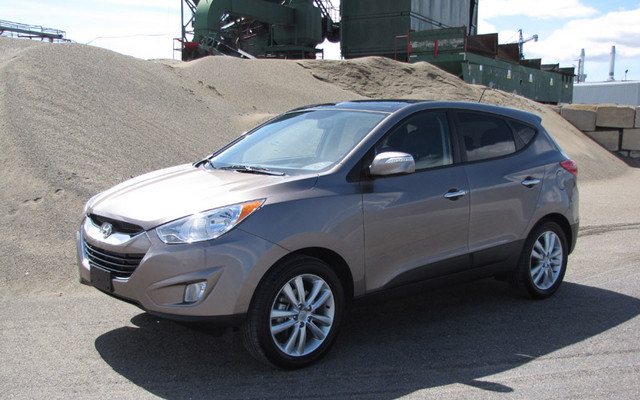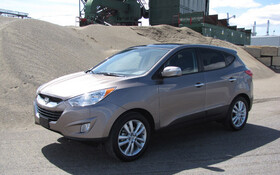Hyundai Tucson vs Volkswagen Tiguan: Two real compacts
While compact SUVs are extremely popular in Europe, our southern neighbours seem to be buying them with less enthusiasm. In our neck of the woods, these vehicles are increasingly in demand. Over the years, most compact SUVs have increased in size, but five of them have stayed true to their original blueprint, including the Hyundai Tucson Limited AWD and the Volkswagen Tiguan Highline 4MOTION. So, let’s compare the two.
Mirror, mirror, on the wall...
Both vehicles are pretty, but in my opinion the Tucson is the fairest of them all. The Tucson looks like an SUV, while the Tiguan looks more like a plus-sized Volkswagen Golf Plus. They’re almost identical in length, around 4400 mm – falling a little short of the other vehicles in this category, which tend to surpass 4600 mm.
The Hyundai Tucson has the same base structure as the new generation Avante (Elantra) which was recently launched in South Korea. Meanwhile, the Tiguan is built on the structure of the Passat. This means that the Tiguan is very rigid, while the Tucson’s rigidity has improved, but still needs improvement.
A difference in space
With ground clearance being just 170 mm for the Tucson and 175 mm for the Tiguan, climbing into either of these vehicles is a piece of cake. However, the Tucson’s rear doors don’t open very wide, which hinders accessibility somewhat.
The Hyundai Tucson can comfortably seat five passengers. The Tiguan, in contrast, seats five, but those on the back bench may find themselves a little squished. The Tucson also offers more generous legroom in the back than the Tiguan, though the Volkswagen makes up for that in headroom.
Both the Hyundai and the Volkswagen offer a very good driving position. Their bucket seats may be quite different, but in both cases they are supremely comfortable and have multiple electronic adjustment possibilities. The Tucson’s back bench is more comfortable than the Tiguan’s, mostly because the seat back on the German vehicle is very firm. In both, the bench has been raised to give passengers a better view.
Inside both vehicles, the dashboard design is terrific, the layout is ergonomic, the instrumentation is easy to read and the controls are user-friendly. Fit and trim is good on both, but the quality is better on the Tiguan. Soundproofing is up to snuff for both vehicles, though a weak point for the Tucson is that noise from the tires makes its way in via the fenders.
There is ample storage space in both vehicles, but it’s more practical and generous inside the Tucson. The back benches can be folded down to create a flat floor. On the Tiguan, the bench also slides forward for additional cargo space, and there is additional storage around the spare tire under the floor. The cargo volume on the Tucson varies between 728 and 1580 litres, while Tiguan offers 700 to 1600 litres. The Tucson features three 12V outlets, and the Tiguan has four. Although three-quarter rear visibility is practically non-existant on the Tucson, it is irreproachable on the Tiguan. The German’s side- and rear-view mirrors are better adapted the vehicle.
Two four-cylinders go head-to-head
The Tucson features a 2.4-litre DOHC engine with continuous variable valve timing and direct fuel injection. It delivers 176 hp and 168 lbs-ft of torque at 4,000 rpm. Although this engine is less discreet than the Tiguan’s, it contents itself with regular gas.
The Tiguan, meanwhile, has a 2.0-litre turbocharged engine with direct fuel injection. It’s one of the best engines in the world – some would even call it the best. It produces 200 hp and an impressive torque of 207 lbs-ft at just 1,700 rpm and maintains it up to 5,000 rpm. It’s gentler and quieter than the Tucson’s engine, but requires super gas.
Hyundai engines have a reputation for being reliable when it comes to torque. But Volkswagens tend to have torque to spare. And the two vehicles going head-to-head in this article fit these generalizations perfectly. Therefore, it’s not surprising that the Tucson’s accelerations are good enough for most of us, but you may find yourself having to downshift in order to get enough power for safe passing. For its part, the Tiguan offers impressive accelerations and pick-up. Both vehicles come with an automatic six-speed transmission with manumatic modes – called Shiftronic at Hyundai and Tiptronic at Volkswagen.
Variable geometry
Whether you look on the Hyundai or the Volkswagen, you’ll find an entirely independent suspension with MacPherson struts. The fundamental difference between the suspensions of the two vehicles are the shock absorbers on the rear suspension. The Tucson’s suspension is very dry, conveying all the imperfections in the road, whereas the Tiguan offers a cushier ride. And even though the Tiguan has better road handling, the Tucson’s is consistent, though just a slower speeds.
The Tucson’s power rack-and-pinion steering is a little heavier than the Tiguan’s. Actually, the Tiguan’s steering is superior on all counts. Both SUVs get power-assisted braking with ventilated discs. Braking from 100 km to 0 is prompt and safe in both vehicles. But once you go beyond 120 km/hr, the Tiguan’s stability gives it the upper hand for emergency braking.
The most disappointing thing about the Tucson by far is its Kumho tires, which measure 225/55R18. They’re hard and rather indiscreet (though their grip seems to be good). The Tiguan’s Dunlop tires, measuring 235/50R18, offer a more pleasant and quiet ride, and their grip is consistent with the vehicle’s overall quality.
Summary
Whichever you choose, you’ll find yourself behind the wheel of one of the best SUV compacts on the market. Depending on which model and equipment level you choose, the Tiguan can cost between $2,000 to $3,000 more than the Tucson, whose complete collection of technological driving assistance makes the competition pale in comparison.
Although the Tiguan is powered by one of the best engines in the world, the fact that it requires premium or super gasoline will almost certainly turn off a good number of buyers who would otherwise have loved to drive a petite German SUV – especially considering how pleasant it is to drive and how relatively affordable it is for clients with a comfortable lifestyle.












